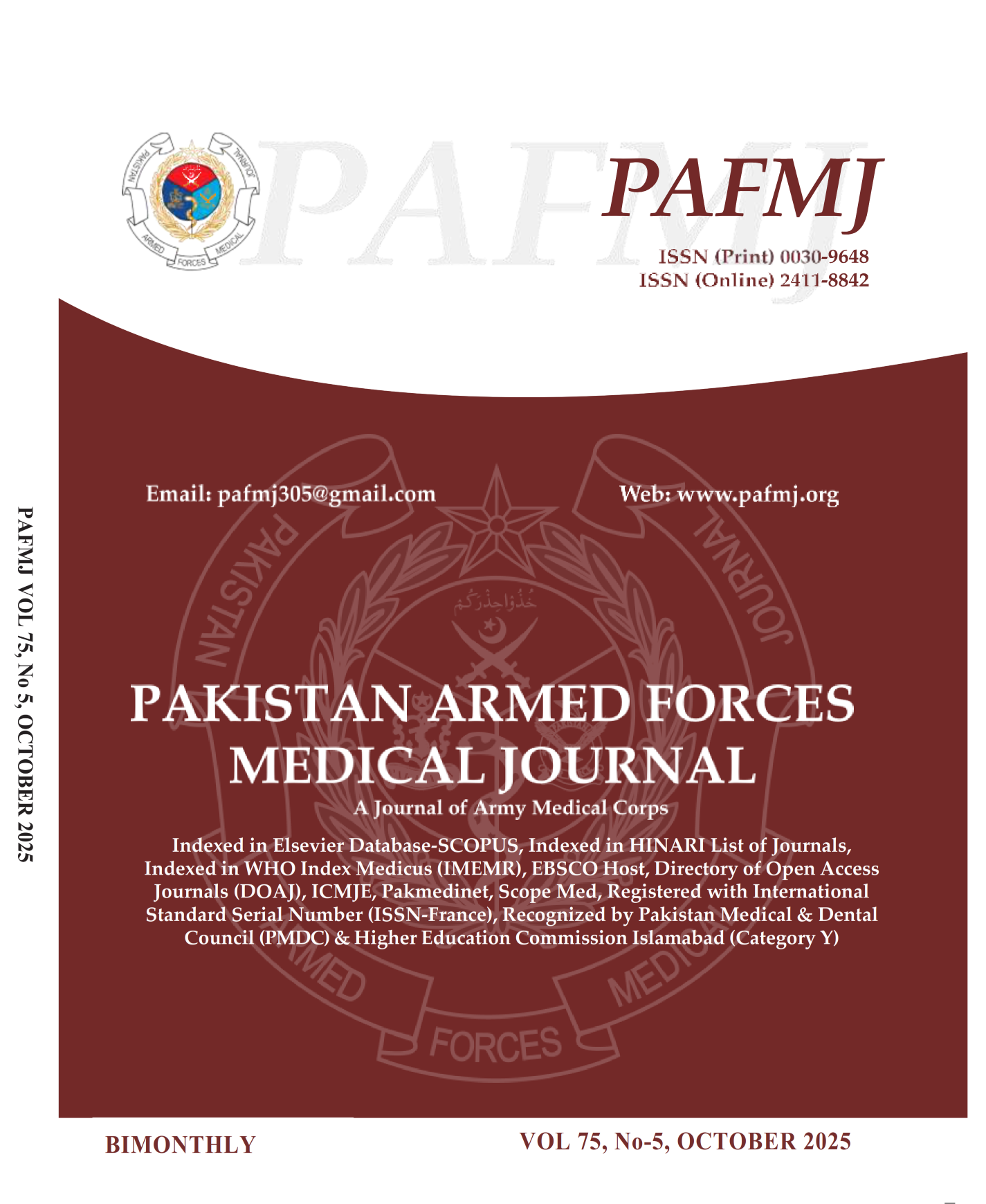Post-Induction Remission Status in B-Acute Lymphoblastic Leukemia Patients (B-ALL), Experience at Tertiary Care Hospital
DOI:
https://doi.org/10.51253/pafmj.v75i5.11301Keywords:
Acute Lymphoblastic Leukaemia, Induction, RemissionAbstract
Objectives: To determine the frequency of post-induction remission status and its association with cytogenetic and molecular abnormalities in patients with B-ALL.
Study Design: Cross-sectional Analytical study.
Place and Duration of Study: Armed Forces Institute of Pathology, Rawalpindi Pakistan, from May to Oct 2023.
Methodology: A total of 112 patients who fulfilled the selection criteria were enrolled after written informed consent. All patients underwent cytogenetic and molecular assessment. Patients were treated using regimen-A for standard risk patients and Regimen-B for high-risk patients, in accordance with the UKALL 2011 guidelines. On day 29 of induction treatment, bone marrow was taken once more, post-induction remission was evaluated, and the results were statistically analyzed.
Results: The mean age of the patients was 5.72+3.48 years. Post-induction remission achieved in 93(83%) patients and was significantly associated with no cytogenetic abnormality (p=<0.01), hyperdiploidy (p=0.027) and t(9;22) (p=0.003), with no molecular abnormality (p=0.038) and mutation in BCR-ABL1 (p=<0.01).
Conclusion: Post-induction remission rate was 83% in B-ALL patients. There was significant association of hyperdiploidy with post induction remission; whereas majority patients t(9;22) and BCR-ABL1 failed to achieve post-induction remission.
Downloads
References
1. Teachey DT, Pui C-H. Comparative features and outcomes between paediatric T-cell and B-cell acute lymphoblastic leukaemia. Lancet Oncol 2019; 20(3): e142–154.
https://doi.org/10.1016/S1470-2045(19)30031-2
2. Samra B, Jabbour E, Ravandi F, Kantarjian H, Short NJ. Evolving therapy of adult acute lymphoblastic leukemia: state-of-the-art treatment and future directions. J Hematol Oncol 2020; 13(1): 70.
http://doi.org/10.1186/s13045-020-00905-2
3. DeAngelo DJ, Jabbour E, Advani A. Recent advances in managing acute lymphoblastic leukemia. Am Soc Clin Oncol Educ 2020; 40(40): 330–342.
http://doi.org/10.1200/EDBK_280175
4. Niaz H, Malik HS, Mahmood R, Mehmood A, Zaidi SA, Nisar U. Clinico-haematologic parameters and assessment of post-induction status in acute lymphoblastic leukaemia. J Ayub Med Coll Abbottabad 2022; 34(3): 458–462.
http://doi.org/10.55519/JAMC-03-10448
5. Pasquini MC, Hu Z-H, Curran K, Laetsch T, Locke F, Rouce R, et al. Real-world evidence of tisagenlecleucel for pediatric acute lymphoblastic leukemia and non-Hodgkin lymphoma. Blood Adv 2020; 4(21): 5414–5424.
http://doi.org/10.1182/bloodadvances.2020003092
6. Brady SW, Roberts KG, Gu Z, Shi L, Pounds S, Pei D, et al. The genomic landscape of pediatric acute lymphoblastic leukemia. Nat Genet 2022; 54(9): 1376–1389.
http://doi.org/10.1038/s41588-022-01159-z
7. Yang M, Tang Y, Zhu P, Lu H, Wan X, Guo Q, et al. The advances of E2A-PBX1 fusion in B-cell acute lymphoblastic Leukaemia. Ann Hematol 2024; 103(9): 3385-3398.
http://doi.org/10.1007/s00277-023-05595-7
8. Brown P, Inaba H, Annesley C, Beck J, Colace S, Dallas M, et al. Pediatric acute lymphoblastic leukemia, version 2.2020, NCCN Clinical Practice Guidelines in Oncology. J Natl Compr Canc Netw 2020; 18(1): 81–112.
http://doi.org/10.6004/jnccn.2020.0001
9. Kakaje A, Alhalabi MM, Ghareeb A, Karam B, Mansour B, Zahra B, et al. Rates and trends of childhood acute lymphoblastic leukaemia: an epidemiology study. Sci Rep 2020; 10(1): 6756.
http://doi.org/10.1038/s41598-020-63528-0
10. Cario G, Leoni V, Conter V, Attarbaschi A, Zaliova M, Sramkova L, et al. Relapses and treatment-related events contributed equally to poor prognosis in children with ABL-class fusion positive B-cell acute lymphoblastic leukemia treated according to AIEOP-BFM protocols. Haematologica 2020; 105(7): 1887–1894.
http://doi.org/10.3324/haematol.2019.231720
11. Chang JH-C, Poppe MM, Hua C-H, Marcus KJ, Esiashvili N. Acute lymphoblastic leukemia. Pediatr Blood Cancer 2021; 68 Suppl 2(S2): e28371.
http://doi.org/10.1002/pbc.28371
12. Lee JW, Cho B. Prognostic factors and treatment of pediatric acute lymphoblastic leukemia. Korean J Pediatr 2017; 60(5): 129–137. http://doi.org/10.3345/kjp.2017.60.5.129
13. Radadiya A, Zhu W, Coricello A, Alcaro S, Richards NGJ. Improving the treatment of acute lymphoblastic leukemia. Biochemistry 2020; 59(35): 3193–200.
http://doi.org/10.1021/acs.biochem.0c00354
14. Alm SJ, Engvall C, Asp J, Palmqvist L, Abrahamsson J, Fogelstrand L. Minimal residual disease monitoring in childhood B lymphoblastic leukemia with t (12; 21)(p13; q22); ETV 6-RUNX 1: concordant results using quantitation of fusion transcript and flow cytometry. Int J Lab Hematol 2017; 39: 121–128.
15. Rafei H, Kantarjian HM, Jabbour EJ. Recent advances in the treatment of acute lymphoblastic leukemia. Leuk Lymphoma 2019; 60(11): 2606–2621.
http://doi.org/10.1080/10428194.2019.1605071
16. Brown PA, Shah B, Advani A, Aoun P, Boyer MW, Burke PW, et al. Acute Lymphoblastic Leukemia, version 2.2021, NCCN clinical practice Guidelines in oncology. J Natl Compr Canc Netw 2021; 19(9): 1079–1109.
http://doi.org/10.6004/jnccn.2021.0042
17. Rana NA, Mahmood A, Robert HM, Zahir S, Ali I, Riaz S. Induction chemotherapy response in childhood acute lymphoblastic leukaemia and its correlation with cytogenetic and molecular features. J Coll Physicians Surg Pak 2022; 32(11): 1430–1434. http://doi.org/10.29271/jcpsp.2022.11.1430
18. Schrappe M, Hunger SP, Pui C-H, Saha V, Gaynon PS, Baruchel A, et al. Outcomes after induction failure in childhood acute lymphoblastic leukemia. N Engl J Med 2012; 366(15): 1371–1381.
http://doi.org/10.1056/NEJMoa1110169
19. Maloney KW, Devidas M, Wang C, Mattano LA, Friedmann AM, Buckley P, et al. Outcome in children with standard-risk B-cell acute lymphoblastic leukemia: Results of children’s Oncology Group trial AALL0331. J Clin Oncol 2020; 38(6): 602–612. http://doi.org/10.1200/JCO.19.01086
20. Inaba H, Mullighan CG. Pediatric acute lymphoblastic leukemia. Haematologica 2020; 105(11): 2524–2539.
http://doi.org/10.3324/haematol.2020.247031
21. Paulsson K. Chromosomal gains as a favorable prognostic factor in pediatric ALL. J Clin Oncol 2023; JCO2301760.
http://doi.org/10.1200/JCO.23.01760
22. Zhou B, Chu X, Tian H, Liu T, Liu H, Gao W, et al. The clinical outcomes and genomic landscapes of acute lymphoblastic leukemia patients with E2A‐PBX1: A 10‐year retrospective study. Am J Hematol 2021; 96(11): 1461–1471.
http://doi.org/10.1002/ajh.26324
23. Reddy P, Shankar R, Koshy T, Radhakrishnan V, Ganesan P, Jayachandran PK, et al. Evaluation of cytogenetic abnormalities in patients with acute lymphoblastic leukemia. Indian J Hematol Blood Transfus 2019; 35(4): 640–648.
http://doi.org/10.1007/s12288-019-01123-8
24. Stock W, Martinelli G, Stelljes M, Deangelo DJ, Gökbuget N, Advani AS, et al. Efficacy of inotuzumab ozogamicin in patients with Philadelphia chromosome-positive relapsed/refractory acute lymphoblastic leukemia. Cancer 2021; 127: 905–913.
25. Cario G, Leoni V, Conter V, Baruchel A, Schrappe M, Biondi A. BCR-ABL1-like acute lymphoblastic leukemia in childhood and targeted therapy. Haematologica 2020; 105(9): 2200–2204.
Downloads
Published
Issue
Section
License
Copyright (c) 2025 Sumaira Ilyas, Helen Mary Robert, Zahoor Hussain, Intzar Ali, Ayesha Wahid, Zara Zafar

This work is licensed under a Creative Commons Attribution-NonCommercial 4.0 International License.















